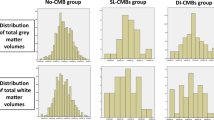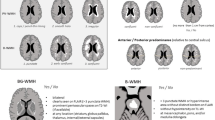Abstract
We compared the severity of white matter T2-hyperintensities (WMH) in the frontal lobe and occipital lobe using a visual MRI score in 102 patients with lobar intracerebral hemorrhage (ICH) diagnosed with possible or probable cerebral amyloid angiopathy (CAA), 99 patients with hypertension-related deep ICH, and 159 normal elderly subjects from a population-based cohort. The frontal-occipital (FO) gradient was used to describe the difference in the severity of WMH between the frontal lobe and occipital lobe. A higher proportion of subjects with obvious occipital dominant WMH (FO gradient ≤−2) was found among patients with lobar ICH than among healthy elderly subjects (FO gradient ≤−2: 13.7 vs. 5.7%, p = 0.03). Subjects with obvious occipital dominant WMH were more likely to have more WMH (p = 0.0006) and a significantly higher prevalence of the apolipoprotein E ε4 allele (45.8% vs. 19.4%, p = 0.04) than those who had obvious frontal dominant WMH. This finding is consistent with the relative predilection of CAA for posterior brain regions, and suggests that white matter lesions may preferentially occur in areas of greatest vascular pathology.


Similar content being viewed by others
References
Bartzokis G, Beckson M, Lu PH, Nuechterlein KH, Edwards N, Mintz J (2001) Age-related changes in frontal and temporal lobe volumes in men: a magnetic resonance imaging study. Arch Gen Psychiatry 58:461–465
Bartzokis G (2004) Age-related myelin breakdown: a developmental model of cognitive decline and Alzheimer’s disease. Neurobiol Aging 25:5–18
De Leeuw FE, De Groot JC, Achten E, Oudkerk M, Ramos LM, Heijboer R, Hofman A, Jolles J, van Gijn J, Breteler MM (2001) Prevalence of cerebral white matter lesions in elderly people: a population based magnetic resonance imaging study. The Rotterdam scan study. J Neurol Neurosurg Psychiatry 70:9–14
Pfefferbaum A, Adalsteinsson E, Sullivan EV (2005) Frontal circuitry degradation marks healthy adult aging: evidence from diffusion tensor imaging. Neuroimage 26:891–899
Vinters HV, Gilbert JJ (1983) Cerebral amyloid angiopathy: incidence and complications in the aging brain. II. The distribution of amyloid vascular changes. Stroke 14:924–928
Kim KW, MacFall JR, Payne ME (2008) Classification of white matter lesions on magnetic resonance imaging in elderly persons. Biol Psychiatry 64:273–280
Smith EE, Gurol ME, Eng JA, Engel CR, Nguyen TN, Rosand J, Greenberg SM (2004) White matter lesions, cognition, and recurrent hemorrhage in lobar intracerebral hemorrhage. Neurology 63:1606–1612
Smith EE, Nandigam KR, Chen YW, Jeng J, Salat D, Halpin A, Frosch M, Wendell L, Fazen L, Rosand J, Viswanathan A, Greenberg SM (2010) MRI markers of small vessel disease in lobar and deep hemispheric intracerebral hemorrhage. Stroke 41:1933–1938
O’Donnell HC, Rosand J, Knudsen KA, Furie KL, Segal AZ, Chiu RI, Ikeda D, Greenberg SM (2000) Apolipoprotein E genotype and the risk of recurrent lobar intracerebral hemorrhage. N Engl J Med 342:240–245
Knudsen KA, Rosand J, Karluk D, Greenberg SM (2001) Clinical diagnosis of cerebral amyloid angiopathy: validation of the Boston criteria. Neurology 56:537–539
Alperovitch A (2003) Vascular factors and risk of dementia: Design of the three-city study and baseline characteristics of the study population. Neuroepidemiology 22:316–325
Viswanathan A, Patel P, Rahman R, Nandigam RN, Kinnecom C, Bracoud L, Rosand J, Chabriat H, Greenberg SM, Smith EE (2008) Tissue microstructural changes are independently associated with cognitive impairment in cerebral amyloid angiopathy. Stroke 39:1988–1992
Holland CM, Smith EE, Csapo I, Gurol ME, Brylka DA, Killiany RJ, Blacker D, Albert MS, Guttmann CR, Greenberg SM (2008) Spatial distribution of white-matter hyperintensities in Alzheimer disease, cerebral amyloid angiopathy, and healthy aging. Stroke 39:1127–1133
Smith EE, Vijayappa M, Lima F, Delgado P, Wendell L, Rosand J, Greenberg SM (2008) Impaired visual evoked flow velocity response in cerebral amyloid angiopathy. Neurology 71:1424–1430
Johnson KA, Gregas M, Becker JA, Kinnecom C, Salat DH, Moran EK, Smith EE, Rosand J, Rentz DM, Klunk WE, Mathis CA, Price JC, Dekosky ST, Fischman AJ, Greenberg SM (2007) Imaging of amyloid burden and distribution in cerebral amyloid angiopathy. Ann Neurol 62:229–234
Ly JV, Donnan GA, Villemagne VL, Zavala JA, Ma H, O’Keefe G, Gong SJ, Gunawan RM, Saunder T, Ackerman U, Tochon-Danguy H, Churilov L, Phan TG, Rowe CC (2010) 11C-PIB binding is increased in patients with cerebral amyloid angiopathy-related hemorrhage. Neurology 74:487–493
Godin O, Tzourio C, Rouaud O, Zhu Y, Maillard P, Pasquier F, Crivello F, Alperovitch A, Mazoyer B, Dufouil C (2010) Joint effect of white matter lesions and hippocampal volumes on severity of cognitive decline: the 3C-Dijon MRI study. J Alzheimers Dis 20:453–463
Yoshita M, Fletcher E, Harvey D (2006) Extent and distribution of white matter hyperintensities in normal aging, MCI, and AD. Neurology 67:2192–2198
van Swieten JC, Hijdra A, Koudstaal PJ, van Gijn J (1990) Grading white matter lesions on CT and MRI: a simple scale. J Neurol Neurosurg Psychiatry 53:1080–1083
Acknowledgments
Yi-Cheng Zhu is funded by the French Chinese Foundation for Science and Applications (FFCSA), the China Scholarship Council (CSC), and the Association de Recherche en Neurologie Vasculaire (ARNEVA). Carole Dufouil has received consulting fees from EISAI. Christophe Tzourio has received investigator initiated research funding from the French National Research Agency (ANR) and has received fees from Sanofi-Synthelabo for participation on a data safety monitoring board and from Merck-Sharp & Dohm for participation on a scientific committee. Hugues Chabriat has already received fees from Eisai, Lundbeck, Servier and Johnson and Johnson companies for participating on data safety and scientific committees in studies unrelated to the present study.
Conflicts of interest
The authors report no conflicts of interest in the present study.
Author information
Authors and Affiliations
Corresponding author
Rights and permissions
About this article
Cite this article
Zhu, YC., Chabriat, H., Godin, O. et al. Distribution of white matter hyperintensity in cerebral hemorrhage and healthy aging. J Neurol 259, 530–536 (2012). https://doi.org/10.1007/s00415-011-6218-3
Received:
Revised:
Accepted:
Published:
Issue Date:
DOI: https://doi.org/10.1007/s00415-011-6218-3




